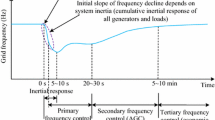Abstract
In this study, a frequency regulation is proposed that adjusts the release of rotational kinetic energy to ensure that a wind turbine remains near the maximum power point in the event of persistent under-frequency. The proposed scheme calculates wind turbine power by multiplying the frequency deviation with the variable control gain and then adding the resulting value to the torque controller power. Considering the operational characteristics of the wind turbine, separate control gains are applied in both the over-frequency section (OFS) and the under-frequency section (UFS). When the rotor speed approaches the maximum power point (MPP), the UFS control gain decreases, causing the wind turbine to gradually transition to maximum power point tracking (MPPT). This overcomes the limitations of conventional frequency regulation, enhancing both the power output of the wind turbine and the average grid frequency. To validate the proposed scheme, an IEEE 14 bus system, including a wind power plant and a photovoltaic plant, was simulated using the EMTP-RV simulator. The simulation results demonstrate that the proposed scheme effectively performs frequency regulation in the power grid regardless of the wind penetration.














Similar content being viewed by others
Data availability
The datasets generated during and/or analyzed during the current study are available from the corresponding author on reasonable request.
References
International Energy Agency.: World Energy Outlook 2022 (2022)
Kim, W.S., Sim, G.H., Lee, K.B., Jeong, B.C., Song, S.H.: Sliding-mode based direct power control of a doubly fed induction generator for wind turbines. Trans. Korean Inst. Power Electron. 13(2), 152–162 (2008)
Jeong, B.C., Song, S.H., Sim, D.J.: A wind turbine simulator for doubly-fed induction-type generator with automatic operation mode change during wind speed variation. Trans. Korean Inst. Power Electron. 11(4), 349–360 (2006)
Choi, J.Y., Choy, I., Song, S.H., An, J., Lee, D.H.: A study of an implementable sun tracking algorithm for portable systems. J. Power Electron. 13(6), 1051–1057 (2013)
Lalor, G., Mullane, A., O’Malley, M.: Frequency control and wind turbine technologies. IEEE Trans. Power Syst. 20(4), 1905–1913 (2005)
Margaris, I.D., Hansen, A.D., Cutululis, N.A., Sorensen, P., Hatziargyriou, N.D.: Impact of wind power in autonomous power systems power fluctuations—modelling and control issues. Wind Energy 14(1), 133–153 (2011)
Im, J.H., Song, S.H., Kang, S.: Analysis and compensation of PCC voltage variations caused by wind turbine power fluctuations. J. Power Electron. 13(5), 854–860 (2013)
Kim, J.J., Song, S.H.: PSCAD/EMTDC simulation model of variable speed wind power generation system using permanent magnet synchronous machine. Trans. Korean Inst. Power Electron. 10(6), 610–617 (2005)
Kim, Y.C., Song, S.H.: Design of speed controller for stall blade wind turbine complying with the speed limit during speed overshoot. Trans. Korean Inst. Power Electron. 27(5), 438–445 (2022)
Wang-Hansen, M., Josefsson, R., Mehmendovic, H.: Frequency controlling wind power modeling of control strategies. IEEE Trans. Sustain. Energy 4(4), 954–959 (2013)
Kim, Y., Kang, M., Muljadi, E., Park, J.W., Kang, Y.C.: Power smoothing of a variable-speed wind turbine generator in association with the rotor speed-dependent gain. IEEE Trans. Sustain. Energy 8(3), 990–999 (2017)
Yoo, J.I., Kang, Y.C., Yang, D., Kim, K.H., Park, J.W.: Power smoothing of a variable-speed wind turbine generator based on a two-valued control gain. IEEE Trans. Sustain. Energy. 11(4), 2765–2774 (2020)
Jonkman, J., Butterfield, S., Musial, W., Scott, G.: Definition of a 5-MW Reference Wind Turbine for Offshore System Development. National Renewable Energy Lab. Golden (2009)
Zhao, X., Yan, Z., Xue, Y., Zhang, X.: Wind power smoothing by controlling the inertial energy of turbines with optimized energy yield. IEEE Access. 5, 23374–23382 (2017)
Østergaard, K.Z., Brath, P., Stoustrup, J.: Estimation of effective wind velocity. J. Phys. Conf. Ser. 75(1), 012082 (2007)
Jena, D., Rajendran, S.: A review of estimation of effective wind velocity based control of wind turbines. Renew. Sustain. Energy Rev. 43, 1046–1062 (2015)
Acknowledgements
This study was supported by Korean Energy Technology Evaluation and Planning (KETEP) and Kwangwoon university. (Grant Numbers 20223030020110 and 2023-0433)
Author information
Authors and Affiliations
Corresponding author
Ethics declarations
Conflict of interest
On behalf of all authors, the corresponding author states that there is no conflict of interest.
Rights and permissions
Springer Nature or its licensor (e.g. a society or other partner) holds exclusive rights to this article under a publishing agreement with the author(s) or other rightsholder(s); author self-archiving of the accepted manuscript version of this article is solely governed by the terms of such publishing agreement and applicable law.
About this article
Cite this article
Kim, YC., Song, SH. Frequency regulation algorithm of wind turbines with control gain based on maximum power point estimation. J. Power Electron. 24, 414–424 (2024). https://doi.org/10.1007/s43236-023-00732-x
Received:
Revised:
Accepted:
Published:
Issue Date:
DOI: https://doi.org/10.1007/s43236-023-00732-x



